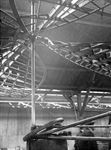Фотографии
-
In January 1920 Damblanc and the Alerion were paid a visit by Japanese General Count Gaishi Nagaoka, seen here third from right. Damblanc is furthest right. As well as being an important figure in early Japanese aviation, Nagaoka was also renowned at the time for having the world’s second-largest moustache!
Самолёты на фотографии: Lecoin-Damblanc Alerion - Франция - 1920
-
AN ALERION ROTARY WING IN THE WORKSHOP
Самолёты на фотографии: Lecoin-Damblanc Alerion - Франция - 1920
-
With one of its two intended le Rhone rotary engines and only one of its rotary wings fitted, Louis Damblanc’s Alerion is prepared for testing at Villacoublay on September 14, 1920. Damblanc had dismissed the co-axial concept and was instead pursuing the idea of two laterally mounted rotors, as per Louis Lacoin’s patents.
Самолёты на фотографии: Lecoin-Damblanc Alerion - Франция - 1920
-
The Alerion is prepared for testing at Villacoublay on September 14, 1920. Only one rotary wing and le Rhone engine has been fitted and the empennage, comprising fin, rudder and tailplane, is also missing.
Самолёты на фотографии: Lecoin-Damblanc Alerion - Франция - 1920
-
Two views of the model of the Alerion which may have been displayed at the 6e Salon de l’Aeronautique in Paris in December 1919 and January 1920. The fuselage remained uncovered to avoid aerodynamic interference with the rotors, but presumably also to keep the machine’s weight down; it would need all the help it could get.
Самолёты на фотографии: Lecoin-Damblanc Alerion - Франция - 1920
-
The Alerion begins to come together at the Institut Aerotechnique de St-Cyr during the winter of 1919-20. The rotary wings were constructed along the same lines as a conventional wing, with ribs and spars that were to be covered with fabric and doped. The undercarriage was carried on a standard V-frame with an aerodynamic fairing fitted to the axle.
Самолёты на фотографии: Lecoin-Damblanc Alerion - Франция - 1920
-
Crunch! Taken a few minutes after the previous photo, this one shows the Alerion after the engine run, during which substantial damage was inflicted; the rotor was all but destroyed, as was the shaft on which it was fitted and the upper lateral support beam. It was the end of the short career of the Alerion.
Самолёты на фотографии: Lecoin-Damblanc Alerion - Франция - 1920
-
Самолёты на фотографии: Lecoin-Damblanc Alerion - Франция - 1920
-
One of the illustrations included in Damblanc’s 1922 patent for an intriguing helicopter design; quite how it was to work remains something of a mystery, although it may have operated on a similar basis to the later German Focke-Wulf “Triebflugel” concept.
Самолёты на фотографии: Lecoin-Damblanc Alerion - Франция - 1920
-
Of more recognisably conventional configuration was Louis Lacoin’s 1926 patent describing an Alerion-type machine - but, interestingly, with what appears to be an early incarnation of the “fenestron” ducted-fan later used in various French helicopter designs.
Самолёты на фотографии: Lecoin-Damblanc Alerion - Франция - 1920
-
Illustrations from Louis Lacoin’s 1915 patent for “a rotary-wing aircraft with the general shape of an aeroplane”. The tail surfaces are of conventional configuration.
Самолёты на фотографии: Lecoin-Damblanc Alerion - Франция - 1920
-
This plan view from the 1915 patent of Lacoin’s machine perhaps shows the aircraft’s configuration to best advantage; note its distinctive “shamrock”-shaped rotary wings.
Самолёты на фотографии: Lecoin-Damblanc Alerion - Франция - 1920
Статьи
- -
- A.Tincopa - Wings over Peru
- B.Turpin - Brief encounter
- F.Villeneuve - Hawk One (1)
- J.-C.Carbonel - France's Air Pioneers: Louis Damblanc
- K.Hayward - AFVG "A political problem for both sides..."
- L.Andersson - Dirty secrets
- M.Wickstead - Italy's forgotten airlines (1)
- P.Davidson - Off the Beaten Track...
- P.Jarrett - Lost & Found
- P.Lewis - Switzerland's Tiger Force
- P.Vabre - From Flying to Spying (2)
- T.Culbert - The Hump pioneers
- U.Vicenzi - "The most important Bristol engine of all time"











